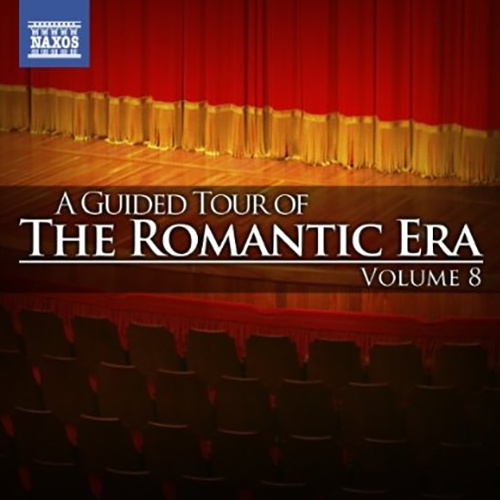A Guided Tour of the Romantic Era, Vol. 8
Naxos 2013
![]()
![]()
![]()
A Guided Tour of the Romantic Era, Vol. 8
In the sphere of instrumental music, the virtuoso reigned supreme. Performers like Liszt and Paganini filled concert halls again and again, inspiring near-hysterical devotion in their fans. Composers and performers had more-or-less completely broken away from the bonds of patronage – the public had now become the supreme arbiter of musical taste.
Underpinning all this was the way in which music reflected the political upheavals of the period as societies strived to throw off established autocratic rule. A sense of national identity became more evident in European music, with composers becoming acutely aware of their roots: among others, Schubert, Brahms and Wagner in Germany; Verdi and Bellini in Italy; Chopin, Debussy and Berlioz in France; Tchaikovsky and Mussorgsky in Russia; Dvořák and Smetana in Eastern Europe; and Grieg in Norway.
Album information taken from: http://www.classicsonline.com/promos/Guided-Tours-Romantic-Era.html
Artists and Orchestras:
Eldar Nebolsin (piano), Jeno Jando (piano), Philip Thomson (piano), Giuseppe Andaloro (piano), Andreas Rothkopf (organ), Folke Alin (choirmaster), Christina Hornell (choirmaster), Goran Eliasson (tenor), John Erik Eleby (bass), Lennart Forsen (bass), Lars Cleveman (tenor), Marian Vach (choirmaster), Domenico Trimarchi (baritone), Alessandro Cosentino (tenor), Enrico Facini (tenor), Franco de Grandis (bass), Elena Filipova (soprano), Carlo Colombara (bass), Cesar Hernandez (tenor), Gloria Scalchi (mezzo-soprano), Matthew Polenzani (tenor), Valerian Ruminski (bass), Indra Thomas (soprano), Ana Maria Martinez (soprano), Ingrid Kertesi (soprano)
Polish National Radio Symphony Orchestra, Franz Liszt Academy of Music Orchestra, Royal Liverpool Philharmonic Orchestra, Austrian Radio Symphony Orchestra, Swedish Opera Orchestra, Stuttgart State Opera Orchestra, Royal Swedish Opera Chorus, Royal Swedis, Michael Halasz, Andras Ligeti, Vasily Petrenko, Pinchas Steinberg, Leif Segerstam, Lothar Zagrosek, Johannes Wildner, Alexander Rahbari, Daniele Callegari, Ricco Saccani, Oliver Dohnanyi, Jose Serebrier, Will Humburg, Pier Giorgio Morandi, Richard Hayman
Tracklisting
Les Preludes, S97/R414
Franz Liszt: Eine Faust-Symphonie in drei Charakterbildern, S108/R425: I. Faust
Eine Faust-Symphonie in drei Charakterbildern, S108/R425: I. Faust
Franz Liszt: Piano Concerto No. 1 in E-Flat Major, S124/R455
Piano Concerto No. 1 in E-Flat Major, S124/R455: Allegro maestoso – Tempo giusto
Franz Liszt: Piano Concerto No. 2 in A Major, S125/R456
Piano Concerto No. 2 in A Major, S125/R456: Allegro moderato
Franz Liszt: Totentanz, S126/R457
Totentanz, S126/R457
Franz Liszt: Annees de pelerinage, 1st year, Switzerland, S160/R10
Annees de pelerinage, 1st year, Switzerland, S160/R10: No. 2. Au lac de Wallenstadt (At the Lake of Wallenstadt)
Franz Liszt: Annees de pelerinage, 2nd year, Italy, S161/R10b
Annees de pelerinage, 2nd year, Italy, S161/R10b: No. 1. Sposalizio (Marriage of the Virgin)
Franz Liszt: Annees de pelerinage, 2nd year, Italy supplement, S162/R10: Venezia e Napoli
Annees de pelerinage, 2nd year, Italy supplement, S162/R10: Venezia e Napoli: No. 1. Gondoliera (Gondolier’s Song)
Franz Liszt: Annees de pelerinage, 3rd year, S163/R10
Annees de pelerinage, 3rd year, S163/R10: II. Aux cypres de la Villa d’Este I (To the Cypresses of the Villa d’Este I: Threnody)
Franz Liszt: 12 Etudes d’execution transcendante, S139/R2b
12 Etudes d’execution transcendante, S139/R2b: No. 2 in A Major, “Fusees”
Franz Liszt: Consolations, S172/R12
Consolations, S172/R12: No. 3. Lento placido
Franz Liszt: Harmonies poetiques et religieuses, S173/R14
Harmonies poetiques et religieuses, S173/R14: II. Ave Maria
Franz Liszt: 19 Hungarian Rhapsodies, S244/R106
19 Hungarian Rhapsodies, S244/R106: No. 2 in C-Sharp Minor
19 Hungarian Rhapsodies, S244/R106: No. 10 in E Major, “Preludio”
Franz Liszt: Der Tanz in der Dorfschenke, S514/R181, “Mephisto Waltz No. 1”
Der Tanz in der Dorfschenke, S514/R181, “Mephisto Waltz No. 1”
Franz Liszt: Piano Sonata in B Minor, S178/R21
Piano Sonata in B Minor, S178/R21
Franz Liszt: Prelude and Fugue on the name B-A-C-H, S260/R381
Prelude and Fugue on the Name B-A-C-H, S260/R381: Prelude
Franz Liszt: Fantasy and Fugue on the Chorale Ad nos, ad salutarem undam by G. Meyerbeer, S259/R380
Fantasy and Fugue on the Chorale Ad nos, ad salutarem undam by G. Meyerbeer, S259/R380
Richard Wagner: Der fliegende Hollander (The Flying Dutchman): Overture
Der fliegende Hollander (The Flying Dutchman): Overture
Richard Wagner: Tristan und Isolde
Tristan und Isolde, Act I: Prelude
Richard Wagner: Das Rheingold
Das Rheingold: Prelude
Richard Wagner: Die Walküre, 3. Akt: Walkürenritt
Die Walkure, Act I: Prelude
Richard Wagner: Siegfried
Siegfried, Act I: Vorspiel
Richard Wagner: Götterdämmerung
Gotterdammerung (Twilight of the Gods), Prologue: Einleitung
Richard Wagner: Die Meistersinger von Nurnberg (The Mastersingers of Nuremberg) .
Die Meistersinger von Nurnberg (The Mastersingers of Nuremberg), Act III: Finale
Richard Wagner: Tannhauser
Tannhauser, Act II: The Guests’ Procession into the Hall of Song in the Wartburg
Richard Wagner: Parsifal .
Parsifal, Act I: The Journey to Montsalvat (The Castle of the Guardians of the Grail)
Richard Wagner: Lohengrin
Lohengrin, Act II: Bridal Procession
Richard Wagner: Rienzi
Rienzi, Act II: The Messengers of Peace
Richard Wagner: Siegfried Idyll, WWV. 103
Siegfried Idyll
Giuseppe Verdi: Rigoletto
Rigoletto, Act I: Prelude
Giuseppe Verdi: La traviata
La Traviata, Act I: Prelude
Giuseppe Verdi: Macbeth
Macbeth, Act I: Preludio
Giuseppe Verdi: Aida
Aida: Prelude
Giuseppe Verdi: Otello
Otello, Act I: Fuoco di gioia
Giuseppe Verdi: Otello, Act III Scene 7: Ballabile
Otello, Act III: Ballabile
Giuseppe Verdi: Falstaff
Falstaff, Act I: Falstaff! Ola!
Giuseppe Verdi: La forza del destino
La forza del destino: Overture
Giuseppe Verdi: Messa da Requiem
Messa da Requiem: Requiem: Requiem aeternam
Giuseppe Verdi: 4 Pezzi sacri
4 Pezzi sacri: No. 1. Ave Maria
Charles-Francois Gounod: Faust
Faust, Act II: Ainsi que la brise legere
Faust, Act II: Quel trouble inconnu me penetre! … Salut! Demeure chaste et pure
Faust, Act IV: Alerte! Alerte! Ou vous etes perdus!
Charles-Francois Gounod: Romeo et Juliette
Romeo et Juliette, Act I: Je veux vivre
Gounod: Ave Maria (version for voice and orchestra)
Ave Maria (version for voice and orchestra)

